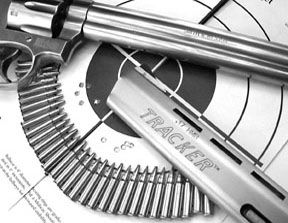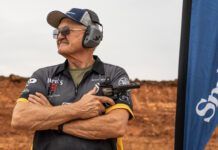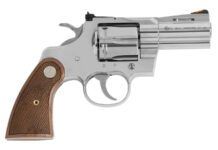
Many companies have shown they can chamber revolvers with nearly any length of cartridge, but there can still be problems — in particular, maintaining headspace, the distance between the head of the cartridge and the breechface. The cause: Narrow chambers fill with debris, making complete chambering difficult. This can hamper rotation and present a safety hazard. This is especially true of rimfires, unlike a centerfire round whose primer is recessed and protected by the case. With a rimfire, there has always been concern that hitting the case edge on the breech while closing the cylinder could ignite the cartridge.
We noted function (but not safety) problems when we recently tested two double-action guns chambered for the .17 Hornady Magnum Rifle cartridge: the Smith & Wesson Model 647, $677; and the Taurus International M17 Tracker, $438. Next month, we look at two single-action revolvers chambered for the increasingly popular round.
The .17 HMR has been described as a Winchester Magnum Rifle (WMR) case necked down in the final 0.2 inches of its length to secure a boattail rifle bullet measuring approximately 0.17 inch in diameter. Given the higher velocity of this round compared to the .22 WMR, we wanted to know if accuracy would be effected pro or con. Also, would the unique profile of this rimfire round solve headspacing problems or create new ones? We began shooting to find out:
[PDFCAP(1)]A face-off between Smith & Wesson and Taurus wheelguns often proves to be an exercise in comparing the yin versus yang of revolver design. The most notable difference between the two guns includes Smith & Wesson’s preference of a flat leaf mainspring versus the coiled wire design of the Taurus. Both manufacturers have incorporated a one-piece rubber grip and full lug barrel with enclosed ejector rod. Other characteristics common to our two test guns include adjustable sights with pinned front blade, wide hammer tang and smooth faced trigger. The Smith & Wesson 647 has the longer barrel of the two guns, measuring 8.4 inches, and the frame has a round butt.
However, the main difference between the two guns concerns chambering the .17 HMRs.
The 647 features beautifully made recessed cylinders that allow the rounds to be seated flush. Recessed cylinders go back to earlier Smith & Wesson models now coveted by collectors and enthusiasts alike. Practical shooters favor recessed chambers because this feature aids speed loading.
The 647 is heavy forward of the frame, and the spunky .17 HMR round produced little recoil that the heavy underlug and long barrel couldn’t dampen. The .17 HMR slug is very light, and even at speeds approaching 2100 fps with muzzle energy in the 160 foot-pound range, there is little movement to disturb the shooter’s aim. This would lead us to believe that a double-action revolver would be ideal for shooting small game. With six rounds available via double action, the potential for rapid follow-up shots should be an advantage, at least in theory. However, we found that the gun’s double-action fire was compromised by cylinder drag. Rapid or even consistent double-action fire was interrupted repeatedly by jammed or delayed rotation of the cylinder. This made the double-action press difficult on some shots and almost impossible on others, destroying proper aim.
We think this was caused by “setback.” This is when the cartridges fall away from their proper seating in the chamber and rub against the breechface during rotation. We think setback is the cause because we could not find any scratch or mark on the front of the cylinder that would indicate contact with forcing cone. Also, the cylinder was moving freely as well. With the cylinder in place but empty, the double action trigger operated freely. With the cylinder out of the frame and the ejector button held back to duplicate the hold position, the double-action trigger also moved without delay. Loading the cylinder with only one round did not cause drag. Loading the cylinder with two rounds did not cause drag. Loading the cylinder with three rounds caused drag more than half the time. Loading four or more rounds consistently produced drag. We found this same problem, but to a lesser degree in the Taurus 17. Working from the theory that setback was the problem, we would conclude that the tapered profile of the .17 HMR has presented a new problem for manufacturers of double-action revolvers.
[PDFCAP(2)]To evaluate the accuracy of our two revolvers we fired single action only at 25 yards. We found that manually pulling back the hammer helped us minimize the problem of difficult cylinder rotation. We did experience some drag from time to time when pulling back the hammer (which also rotates the cylinder counterclockwise), but the effect was not crucial. This is because in single-action fire, refining the sight picture is not done simultaneously with rotating the cylinder. Therefore, cylinder drag never affected the quality of our trigger press or the results of our shot. The Smith & Wesson featured a heavy feel to its single-action trigger that broke cleanly. Our test staff agreed this was ideal. In fact, we feel each of these guns would have been better challenged with a bench session aimed at targets 50 yards away rather than our standard 25-yard procedure. Even with the limited choices of .17 HMR ammunitions, each gun was able to shoot five-shot groups smaller than 1 inch. Our largest groups for each gun measured only 1.4 inches, and we can’t be sure if it was an imperfection of the gun or we just pulled the shot. With this level of accuracy, we think many buyers will be satisfied with this revolver even if they limit their shooting to single action.
[PDFCAP(3)]The Tracker series from Taurus is an improvement from the standard models of just a few years ago. Visually, they are a smaller version of the extra-large-framed revolvers that started with the Raging Bull. This profile includes a full-lug barrel with vented cut outs and a pinned front sight. We like the matte finish, and the coiled mainspring seems to be fashioned from larger-diameter wire with more coils than before. The bugaboo with coiled mainsprings was always the phenomena of stacking. This creates the feeling that the further one presses the trigger the more resistance is felt. In our opinion we feel there has been a noticeable improvement in this area since the introduction of the Tracker series, and the model 17 is no exception.
Shooter comfort is also aided by the Taurus ribbed grip. This grip, like the Hogue Monogrip found on the Smith & Wesson 647, is one piece and secured at the bottom of the grip. The Smith & Wesson uses a slotted screw, and the Taurus M17 uses an Allen screw. In both cases the screws cannot interfere with the surface of the shooter’s hand. This also means that should the mounting screw come loose, it does not affect the alignment of the grip as it may when the screw is also used to hold together two separate panels. The Taurus grip does not offer finger grooves, but the fine ribs tend to take the shape of the shooter’s hands as well as adding shock-absorbing comfort. Although absorbing harsh recoil is not really the issue here, each of the grips on our test guns added to the experience.
The primary difference between the approach taken by Taurus and Smith & Wesson in chambering the .17 HMR is how the ammunition is held in the individual chambers. The entire rear face of the cylinder of the Taurus is recessed. Once loaded, the rims of each cartridge seem to protrude, which gives an entirely different look than the 647. But did this design prove more successful in avoiding rotation problems? No, not entirely. In performing our test of progressively loading the cylinder with more and more rounds, problems did not occur until all chambers were filled. This is a good time to mention that the Tracker M17 is a seven-shooter, and firing double action we rarely encountered any interruption in the trigger until attempting the sixth or seventh shot. This is an improvement over our experience firing the Smith & Wesson but hardly what either manufacturer had in mind. So we limited our collection of accuracy data to single action.
The Taurus rear sight used a white outline of the notch, but we found that to be superfluous. We thought the rear sight was very good nonetheless. The front blade was a ramp that included a red insert with serrations at the lower part of the ramp. We found that we could not really pick up the color of the insert in bright sunlight, and its flat surface produced unwanted glare. We thought the front sight blade of the Smith & Wesson, which consisted of a rectangular-faced patridge, was much more suitable.
However, we were able to overcome the glare of the Taurus front sight by applying Birchwood Casey’s sight black. The single-action trigger on the Taurus did not have the same “heavy” feeling as the Smith & Wesson, but the single-action trigger on each gun broke at 5 pounds.
The smallest measured group overall went to the Tracker (0.7 to 0.8 inch). The largest overall groups were a tie. To break the tie for best average group for all groups fired would have required calculation to the hundredth of an inch.
However, because both guns displayed rotation problems during double-action fire, we assume this is an inherent problem with chambering the round. Perfection may come as soon as the next production run. In the meantime, we found that both guns shot exceptionally well, and we think the .17 HMR cartridge itself should also take a bow. If there is any real difference between the accuracy of these guns, perhaps it could be found by mounting a scope on each of them and testing them at much greater distance.
Gun Tests Recommends
Smith & Wesson 647 .17 HMR, $677. Conditional Buy. Fired single action this model is one the best rimfire revolvers we have seen yet. But the 647 is supposed to offer double-action fire as well, and rotation problems compromised this feature, in our view.
Taurus Tracker M17 .17 HMR, $438. Conditional Buy. The Tracker proved to be an excellent shooter, but it also suffered rotation problems in double action (although they were not as severe as those found in the Smith & Wesson 647). Until changes are made, the lower price and seven-round capacity of the Taurus are pluses only if the shooter can view this gun as a single action.




























